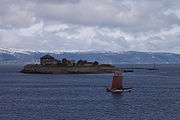
Nidarholm Abbey
Encyclopedia

Munkholmen
Munkholmen is an islet north of Trondheim, Norway. It sits in the Trondheimsfjord about northwest of the island of Brattøra and the mouth of the river Nidelva. The islet has served as a place of execution, a monastery, a fortress, prison, and a World War II anti-aircraft gun station...
in the Trondheimfjord on the sea approach to Trondheim
Trondheim
Trondheim , historically, Nidaros and Trondhjem, is a city and municipality in Sør-Trøndelag county, Norway. With a population of 173,486, it is the third most populous municipality and city in the country, although the fourth largest metropolitan area. It is the administrative centre of...
, Norway
Norway
Norway , officially the Kingdom of Norway, is a Nordic unitary constitutional monarchy whose territory comprises the western portion of the Scandinavian Peninsula, Jan Mayen, and the Arctic archipelago of Svalbard and Bouvet Island. Norway has a total area of and a population of about 4.9 million...
.
History
The monastery was founded either in 1028 by Canute the GreatCanute the Great
Cnut the Great , also known as Canute, was a king of Denmark, England, Norway and parts of Sweden. Though after the death of his heirs within a decade of his own and the Norman conquest of England in 1066, his legacy was largely lost to history, historian Norman F...
, or in about 1100 by Sigurd Ullstreng, a vassal of Magnus Berrføtt. It was dedicated to Saint Benedict
Benedict of Nursia
Saint Benedict of Nursia is a Christian saint, honored by the Roman Catholic Church as the patron saint of Europe and students.Benedict founded twelve communities for monks at Subiaco, about to the east of Rome, before moving to Monte Cassino in the mountains of southern Italy. There is no...
and Saint Laurence. The monastery had some connection with the Cluniacs, but it seems that this connection consisted of the introduction of local reforms based on the practices of Cluny, rather than membership of the Cluniac Order and subordination to Cluny as such.
The English
England
England is a country that is part of the United Kingdom. It shares land borders with Scotland to the north and Wales to the west; the Irish Sea is to the north west, the Celtic Sea to the south west, with the North Sea to the east and the English Channel to the south separating it from continental...
monk and chronicler Matthew of Paris was asked in 1248, while on a diplomatic mission to King Haakon IV
Haakon IV of Norway
Haakon Haakonarson , also called Haakon the Old, was king of Norway from 1217 to 1263. Under his rule, medieval Norway reached its peak....
, to supervise a reform of Nidarholm.
The monastery was a powerful and wealthy one, and traded with England, but suffered serious fires in 1210 and 1317, after which it became less prominent. A final fire took place in 1531 shortly before the Reformation
Protestant Reformation
The Protestant Reformation was a 16th-century split within Western Christianity initiated by Martin Luther, John Calvin and other early Protestants. The efforts of the self-described "reformers", who objected to the doctrines, rituals and ecclesiastical structure of the Roman Catholic Church, led...
.
Nidarholm was the last Roman Catholic stronghold in Norway during the Reformation, under Olav Engelbrektsson
Olav Engelbrektsson
Olav Engelbrektsson was the last Catholic Archbishop of Norway. As well as being a religious leader, Olav was also a political figure;...
, Archbishop of Nidaros. His men were besieged in 1537 in Nidarholm by the fleet of Jens Splid, and were eventually forced to surrender.

